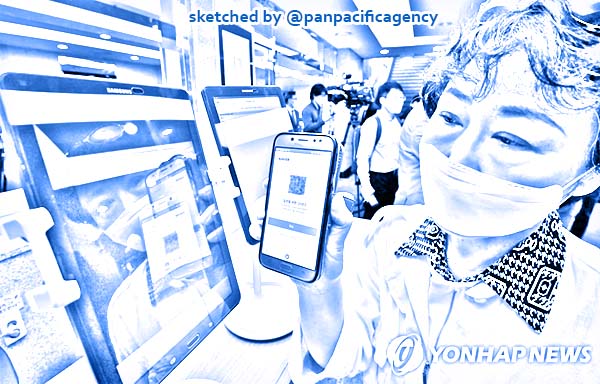[Analytics] South Korea can help drive Asia’s recovery post-Covid-19

A member of a church in the central Seoul ward of Jongno uses a one-time quick response (QR) code to enter the venue on June 2, 2020. (Yonhap). Sketched by the Pan Pacific Agency.
Having been hit early by the COVID-19 crisis, some East Asian economies are also recovering early — including South Korea. Choong Yong Ahn specially for the East Asia Forum.
The early movers should work together to achieve regional economic reconstruction and eventual global recovery. Prioritising the exhaustive prescriptions of the Asian Strategy for Recovery and Reconstruction after COVID-19, released by the ANU’s Asian Bureau of Economic Research (ABER), could be a start.
No one knows exactly when the post-COVID-19 phase will begin. Some big cities in Asia, including Seoul, are still seeing COVID-19 clusters through asymptomatic contagion. Most Asian nations appear to be bogged down by the twin burdens of controlling a domestic pandemic and expanding fiscal and monetary policies in unprecedented ways to rescue their battered economies.
But Asia’s economies must not fall into inward-looking self-reliance. If they do, they risk endangering the long-heralded ‘Asian century’ and even enfeebling regional recovery. Asian economies must escape a ‘walled city’ economy to safeguard the liberal order of not only Asia, but also the world.
South Korea, Asia’s fourth-largest economy and one of the world’s most trade-oriented economies, should make important contributions to ABER’s reconstruction strategy. The strategy calls for regionally coordinated actions to avoid international disruption and economic freefall in Asia.
South Korea suffered an early outbreak of COVID-19 and a subsequent economic meltdown. But it also won international praise for how it dealt with the pandemic without border closures or regional lockdowns. It also pioneered quick mass-testing using the world’s first drive-through method, transparent and systematic digital contact tracing, and swift quarantines and voluntary social distancing. While fighting SARS, MERS and now COVID-19, South Korea has accumulated rich data on dealing with infections and treatments.
South Korea should share its COVID-19-fighting strategy — as should other countries that have experienced success, including Taiwan, Vietnam, Singapore and New Zealand — with peer countries still facing a tough uphill battle. The accurate and timely sharing of data between countries is crucial to developing vaccines and cross-border health measures and preventing further outbreaks.
Despite South Korea’s success in fighting the pandemic, its economy now suffers from vicious cycles of contraction and is entering uncharted modern economic territory. The Bank of Korea projected South Korea’s economy will grow -0.2 per cent in 2020, falling from its original forecast of 2.1 per cent. In the first 10 days of May, South Korea’s exports fell 46 per cent year-on-year, the worst decline since records began in 1968.
Most painfully, unemployment rocketed, with youth unemployment hitting a record 9.9 per cent in March. The near halt of regional supply chains risks turning South Korea’s small and medium-sized enterprises into zombies. Self-employed food and lodging services were also severely hit due to contracted consumption and a virtual cessation of tourism.
Against this backdrop, South Korea and its neighbours should create intra-regional reciprocal demand to boost growth and bring back laid-off employees — perhaps by re-opening embedded but halted regional supply chains. Regional protocols would allow business travel and select tourism.
As these countries work to transform the global health and economic crisis into renewed momentum for regional free trade and investment, Asia Pacific economies are fortunate to have two ‘mega-deals’ — namely the Regional Comprehensive Economic Partnership (RCEP) and the Comprehensive and Progressive Agreement for Trans-Pacific Partnership (CPTPP) — within its grip. South Korea needs to work proactively for the early implementation of RCEP, which already has a text-based agreement with 15 signatory states and a door open to India. Through further strengthening a regional healthcare clause, action on RCEP could show the world Asia’s determination to safeguard regional and global liberalism.
South Korea should also join, as part of a second batch of economies, the concluded CPTPP — which awaits ratification. It should also push for the eventual amalgamation of RCEP and the Trans-Pacific Partnership, assuming the United States re-joins. There are seven economies that belong to both deals. South Korea should work with them towards open and inclusive East Asian regionalism.
Other ABER recommendations — including those involving e-commerce, digital infrastructure, cyber security, expanded Capability Maturity Model Integration and Asian currency swap networks — could be put under the huge umbrella of the two mega-deals. With the long-term vision of an open ‘East Asian Community’, most Asian economies should be able to avoid choosing between the United States and China in an intensifying bipolar rivalry. For this to happen, the two superpowers must reach an understanding that will not spoil regional cooperation in the post-COVID-19 era.
As it did during the financial turmoil of 1997–98, East Asia needs to reawaken its ‘East Asian identity’ to bring about regional recovery and provide a silver lining to the struggling global economy.
Choong Yong Ahn is Distinguished Professor at the Graduate School of International Studies, Chung-Ang University.